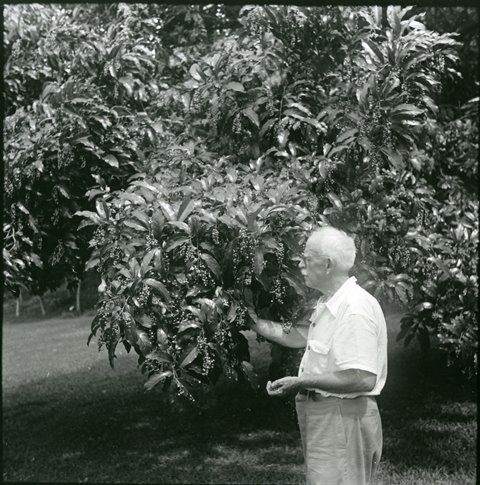From Fairchild
Tropical Botanic Garden
by Noris Ledesma Curator of Tropical Fruit
The Antidesma (Antidesma bunius)
As published in the Miami Herald
Florida is far from exhausting its list of possible fruit for
testing and the antidesma now takes center stage. Dr. David Fairchild,
namesake of Tropical Botanic Garden, first brought the antidesma
to Florida in 1900s from one of his expeditions to the Philippines. He
intended to bring back a berry than can grow in South Florida to please
the new residents coming from north of the United States. It has been
over a century and the antidesma still grows in relative obscurity,
being kept mainly as an ornamental.

There are more than 140 members of the genus Antidesma growing wild in the tropics of the old world, and of the several which have been tried here, Antidesma bunius
is the one that has the most potential as a fruit tree. The antidesma
is native to Southeast Asia, the Philippines, and northern Australia.
It is found wild in the wetter parts of Himalayas southwards and
eastwards, in Sri Lanka, Burma and Malaysia. It has several names
in Java and the Philippines including bignay, banauac, booni,
bugnay or bignai.
It grows into an attractive tree with dark
green and glossy leaves pleasant to touch. The fruits normally appear
during the summer and sometimes extend its season until November. The
fruiting season is typically long, extending from late summer through
the fall and winter, since some trees flower later than others.
Fruiting is in clusters and the fruit ripen unevenly with each bunch
over several weeks. It is a spectacular display, with the clusters
hanging in large racemes turning from green and white and then to red
and black. The trees are highly productive, with plenty of fruit for
birds and humans alike.
The fruits are pleasantly acid and
tender, with a similar taste to the blueberries. When harvesting the
fruit it is recommended to wear gloves because the ripe fruit have red
juice that will stain your fingers. In Malaysia the fruit are used as a
natural dye. In Java they report that the bark is used medicinally, and
in fact some of the natives use antidesma bark to cure for snake bites.
The fruit are also used by native Javanese for syrups and also for
putting into brandy. Dietetically, the fruits are rated as good
source of calcium and contain a fair amount of iron.
Antidesma
has both male and female trees. The male trees will not produce fruit
and are not recommended for planting, unless you do not want fruit.
Most female trees usually bear sufficient quantities of fruit without
having a male tree. The best method to propagate antidesma trees is by
air layers, cuttings or grafting. Seeds sometimes takes nine months or
more to germinate and there is no quarantee of getting a female or for
quality. There are trees available in select local nurseries.
They
generally grow well in most types of soils. Some minor element
deficiencies might occur in alkaline soils, although this can be
corrected with nutritional sprays. Antidesma trees are relatively hardy
and easy to grow. Mature trees will survive temperature down to about
26 degrees without major damage, but young trees will sustain injury at
29 degrees. With ample moisture and good light, it is a very fast
growing tree and can start fruiting within 4 to 5 years. Once well
established, antidesma trees have good drought tolerance and can go for
several weeks without irrigation during our dry season. Trees grow well
close to salt water.
Antidesma is a vigorous tree with a
tendency for producing drooping branches. It needs to be pruned
annually to control the size, shape and to bring the best yield and
fruit quality. Prune the antidesma annually keeping it in the
shape of an open bush so that all branches are bathed in sun to
stimulate fruiting. Grafted trees normally remain bushy and make a good
wind break as well. Antidesma trees can be adapted well for
container culture. They grow well in 20- or 30-gallon containers
producing acceptable quantity of fruit.
There are typically
multiple harvests within a single year. Ripe antidesma fruits have
short shelf life and you must watch your tree closely so as not to lose
the crop. If harvesting for eating fresh one should let the fruit turn
black, when they have a pleasant sweet and tart flavor. The best way to
enjoy the antidesma fruit is to walk out into the garden and strip off
the ripe fruits into your mouth. For processing you can use ripe
(black) fruit or can be pick the fruit when they are still red. It is
better to process the fruit into a juice and freeze it for a final
product. For the ones who enjoy cooking, the juice makes an exceptional
jam, pie, jelly, or even wine, or it can be enjoyed in its pure form.
So plant, care for and enjoy the antidesma, a Florida legacy worth the
investment.
Back to
Bignay Page
|
|
